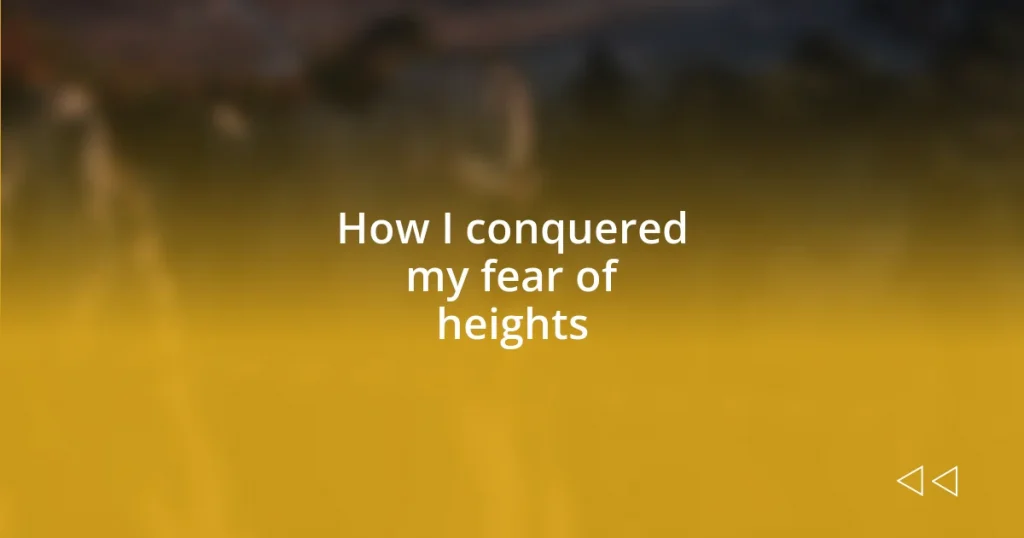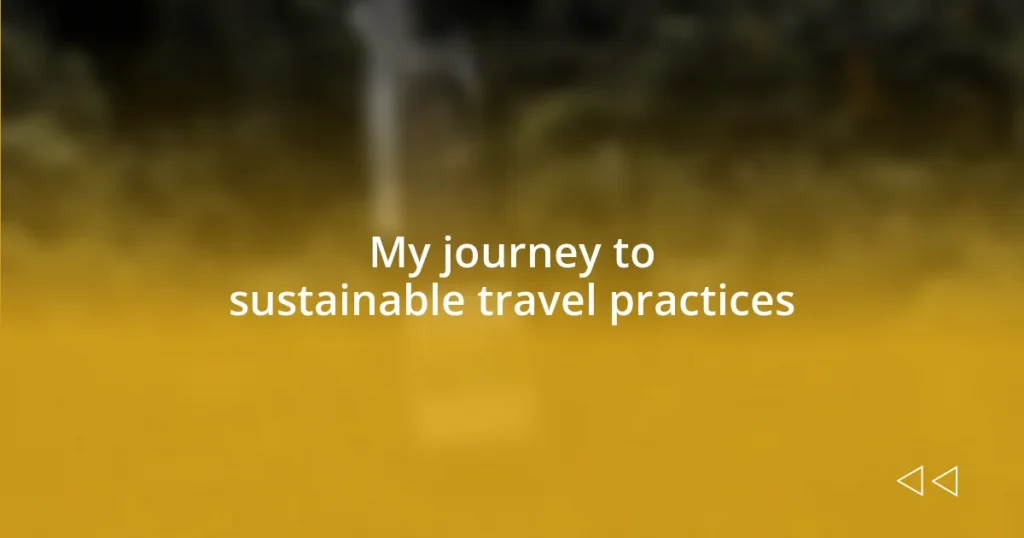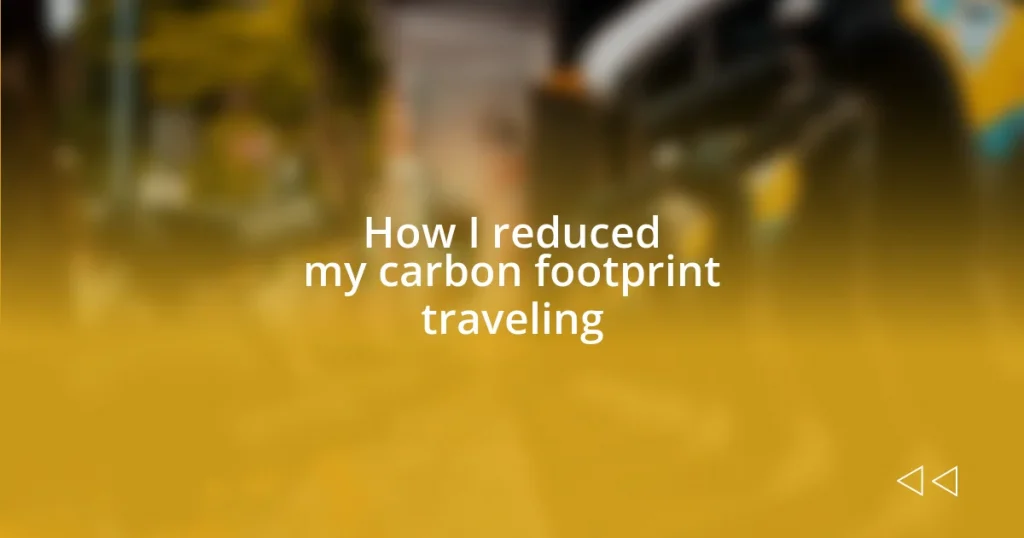Key takeaways:
- Understanding acrophobia involves recognizing triggers, which can range from exposure to heights to past traumatic experiences, allowing for targeted coping strategies.
- Mental preparation techniques such as visualization, gradual exposure, and positive affirmations can significantly enhance confidence and reduce anxiety when confronting heights.
- Celebrating small victories and maintaining motivation through journaling and community support helps reinforce progress and fosters a positive mindset during the journey to overcoming fears.

Understanding fear of heights
Fear of heights, or acrophobia, is a common anxiety that many people experience. I remember the first time I looked down from a tall building; my heart raced, and I felt like I was going to fall through the floor. Isn’t it fascinating how our minds can play tricks on us, making something as sturdy as concrete feel so perilous?
This fear often stems from a primal instinct to protect ourselves from danger. The sensation of vertigo can trigger a flood of adrenaline, leading to a fight-or-flight response that can feel overwhelming. Have you ever wondered why the sight of a steep cliff can cause your hands to sweat? It’s as if our bodies are responding to a hidden threat, even when we know we’re safe.
Interestingly, our past experiences shape how we perceive heights. I once had a near-miss while hiking on a rocky ledge, and that moment has stuck with me. It’s remarkable how a single event can influence our emotions and set off a cycle of fear. Understanding these underlying causes not only sheds light on our reactions but can also be the first step toward overcoming them.

Identifying personal triggers
Recognizing what specifically triggers your fear of heights is crucial in tackling it. For me, it was the sensation of being up high without a barrier that pushed my anxiety buttons. I’d notice my heart racing and my palms sweating whenever I approached a railing without adequate protection. Identifying these moments allowed me to prepare mentally and emotionally for the challenge ahead.
Here are some common triggers that you might relate to:
- Exposure to Heights: Standing on ledges or balconies can provoke immediate anxiety.
- Open Spaces: Being in a wide-open area with a steep drop-off can intensify feelings of vulnerability.
- Fast Movements: Activities like zip-lining or roller coasters can amplify fear due to their sudden shifts in height.
- Lack of Control: Situations where I felt I couldn’t dictate my movements, such as being on a rickety elevator, triggered panic.
- Past Experiences: Memories of a traumatic incident related to heights can resurface and heighten anxiety.
Each of these triggers, once identified, became a focal point for me to work through my fear. Recognizing them gave me a sense of power; instead of being overwhelmed by anxiety, I began to view these situations as opportunities for growth.

Preparing mentally for exposure
Preparing mentally for exposure is a game changer when it comes to confronting fears, especially something as challenging as heights. I remember the nights leading up to my first real exposure—my stomach was in knots just thinking about standing on a tall building’s edge. I started visualizing myself up there, attributing confidence to each scenario. This mental rehearsal not only calmed my nerves but also made me realize that the fear was largely in my mind.
Another aspect I found essential was to break things down into manageable steps. Instead of jumping straight to a high cliff, I practiced in less intimidating environments, like a low balcony. Each little victory built my confidence. For instance, after successfully standing on that balcony, I felt an exhilarating rush, almost like a weight lifting off my shoulders. Have you ever celebrated a small win that felt monumental? That’s how those experiences added up for me.
Affirmations also played a pivotal role in my mental preparation. I started each day with reassuring words to myself, like “I am safe” and “I can conquer this.” It might sound cliché, but it anchored me as I faced new heights. Whenever doubt crept in, repeating these phrases became a lifeline that helped me push through discomfort.
| Preparation Techniques | Description |
|---|---|
| Mental Visualization | Imagining yourself in a safe space at heights helps build confidence before facing real exposure. |
| Gradual Exposure | Starting with lower heights allows you to acclimate gradually, reducing overwhelm. |
| Positive Affirmations | Reassuring self-talk serves as a motivational tool that can enhance mental resilience. |

Gradual exposure techniques
I’ve found that gradual exposure is a powerful technique when it comes to conquering fears. My journey began with something as simple as standing on a chair. At first, it felt monumental; my heart raced, and I questioned my sanity. Yet, with each inch of height gained, I felt a sense of accomplishment. It’s fascinating to think about how a simple chair could spark that change, isn’t it?
As I progressed, I moved to small bridges or stoops with a slight elevation. Each time I faced those situations, I took a moment to breathe deeply and remind myself of my goal. I vividly remember standing on a low bridge looking down at the water below. The world felt both vast and close, but because I had taken those incremental steps, I found myself savoring the moment. It was like an unexpected thrill ride, but instead of fear, I started to feel an exhilarating mix of excitement and empowerment.
Eventually, I began tackling slightly higher heights, like a second-floor balcony. That shift felt monumental after my earlier victories. Each outing became a chance to embrace the feeling of height, rather than shrink away from it. I began asking myself, “What’s truly the worst that could happen?” That simple inquiry helped reframe my perspective, transforming fear into curiosity. The rush of facing my fears brought an incredible sense of liberation, and I’ve never looked back since!

Utilizing breathing exercises
Utilizing breathing exercises was an essential part of my journey. Whenever I felt that familiar tightness in my chest before confronting heights, I would pause and focus on my breath. I would take slow, deep breaths, inhaling deeply through my nose and exhaling slowly through my mouth. This simple act not only calmed my racing heart but also anchored me in the present moment, making me feel more in control. Have you ever noticed how just a few deep breaths can shift your state of mind?
During one of my climbing sessions, I found myself on a surprisingly tall platform, and panic threatened to take over. I remembered to use my breathing techniques. I closed my eyes, took five deep breaths, and gradually felt the knot in my stomach loosen. With each exhale, I imagined releasing not just my breath but also my fear. It was a small yet transformative experience that reinforced how powerful breathing can be in managing anxiety.
Over time, I discovered that pairing breathing exercises with visualization made an even greater impact. As I breathed in deeply, I envisioned a calm ocean, and with each exhale, I let go of the anxiety weighing me down. This dual approach became my go-to strategy every time I faced new heights. Honestly, I can’t help but wonder: if breathing can help so much, what other simple techniques might we overlook in our lives?

Celebrating small victories
Every small victory deserves recognition. I remember when I first stood on that chair; I felt a wave of accomplishment wash over me. It wasn’t just a physical act; it was a mental breakthrough. Celebrating these small moments was essential, as they fueled my motivation to keep pushing forward. Have you ever celebrated a seemingly tiny achievement in your life? It can be surprisingly uplifting.
One day, after successfully crossing that low bridge, I sat down on a nearby bench and took a moment to reflect. My heart was still racing, but it was the kind of exhilaration that made me smile. I savored that fleeting moment of triumph, which reminded me that progress doesn’t always have to be monumental. Recognizing these incremental steps instilled a sense of confidence in me, making my next challenge feel more achievable. Isn’t it amazing how a simple acknowledgment can shift your perspective?
As I tackled higher heights, I realized that the real victory lay in the journey itself. I began to cherish the anticipation of each experience rather than dreading it. For instance, facing a second-floor balcony became a personal celebration, a reaffirmation of my growth. With every breath and every moment spent at a height, I felt empowered to embrace the next challenge. Reflecting on these experiences, I began to understand: it’s these small victories that build the foundation for greater successes. How often do we overlook the importance of celebrating our own achievements?

Maintaining progress and motivation
It’s crucial to find ways to keep that motivation alive. I remember one weekend when I decided to revisit a spot that once terrified me—a tall viewpoint I previously avoided. The adrenaline rush of facing that fear again was exhilarating! Each time I climbed those steps, I could feel the same fear creeping in, but I also felt stronger. Setting little benchmarks, like revisiting places, helped me measure my progress in real-time. Have you ever realized how revisiting something that once scared you can empower you in ways you didn’t expect?
To maintain my momentum, I made it a habit to journal my experiences. After each climbing session, I would jot down my feelings, what I faced, and how I overcame it. This process not only reinforced my victories but also allowed me to analyze my fears more objectively. It was surprising to read back and see just how far I had come. This reflective practice kept me connected to my journey, making me eager for the next challenge. How do you keep track of your progress?
Connecting with others who shared similar experiences was a game-changer for me. Joining a support group or even chatting with friends who understood my struggles provided a sense of community that was incredibly motivating. Hearing about their triumphs and setbacks reminded me that I wasn’t alone on this journey. It felt like we were all climbing our individual mountains together. Isn’t it comforting to know that sharing challenges can foster deeper connections and inspire us to keep moving forward?















